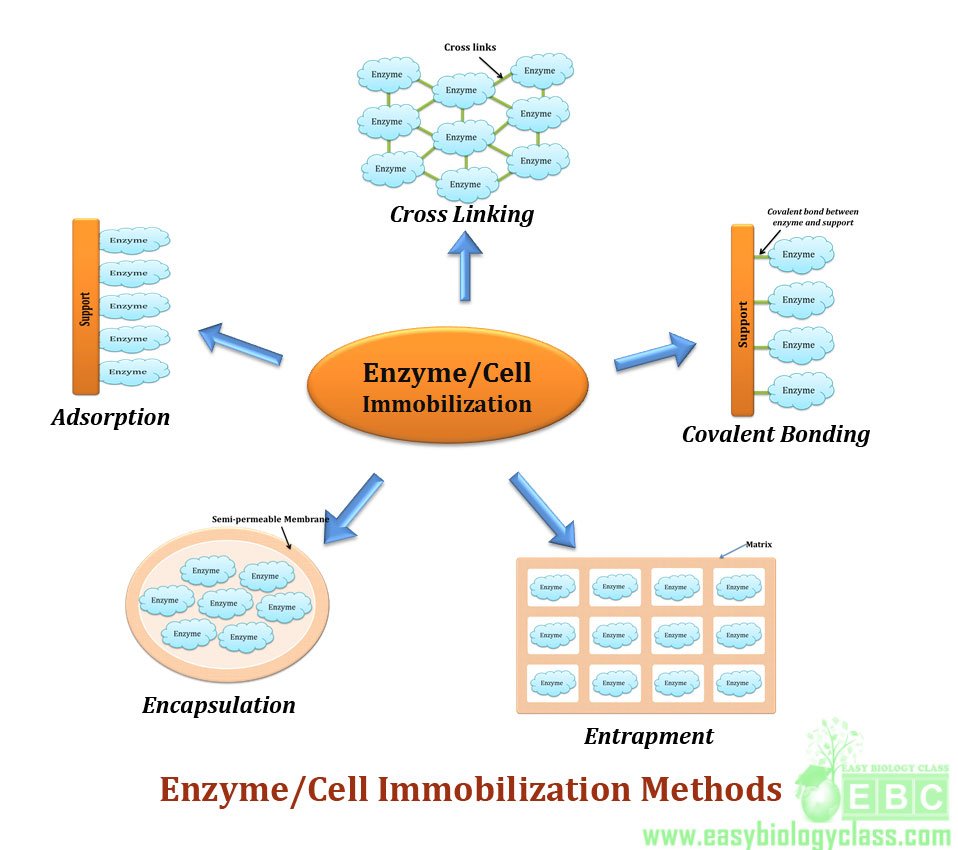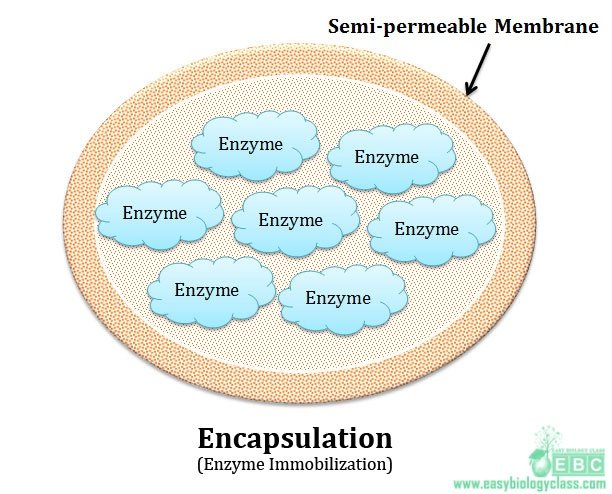Enzyme immobilization techniques
What is enzyme immobilization?
- imprisonment of cell or enzyme in a distinct support(matrix).
- The support/matrix allows change of medium.
- The medium contain substrate or inhibitor molecule.
- First immobilization technology : amino acylases by aspergillus oryzae for the production of L-amino acid japan.
- The main advantages of enzyme immobilization:
2. enhanced reproducibility
Advantages-
- Reuse
- Continuous use
- minimum reaction time
- less chance of contamination
- more stability
- improve in process control
- high enzyme substrate ratio
Disadvantages-
- loss of catalytic properties in sometime
- some enzyme become unstable
- some enzyme are inactivated by heat generation in system
- high cost for isolation, purification and recovery of active enzyme
Application-
- Industrial production: Eg. Antibiotics, beverage ,amino acid etc
- Biomedical application: treatment, diagnosis and drug delivery .
- Food industry: Production of jams, jellies, and syrup.
- Research: blotting experiment, proteases for cell lysis
- Waste water treatment: treatment of sewage & industrial effluents
Support/matrix-
- The enzyme hold in support/matrix
- The should be cheap and easy available
- Their reaction with medium and enzyme should be minimums as possible
- A wide range of matrix are used in immobilization of enzyme/ cell
- Matrix categories into 3 grouped
- Natural polymers
- Synthetic polymer
- Inorganic polymer
Types of immobilization-
- Adsorption
- Covalent bonding
- Entrapment
- Copolymerization
- Encapsulation

(1). Adsorption-
- Oldest method of enzyme immobilization
- Simplest method of enzyme immobilization
- Nelson and Griffin used charcoal to adsorb invertase
- Enzyme are adsorbed to external surface of support
- Support/ carrier may be ;
- Mineral support (aluminum oxide, clay)
- Organic support (starch)
- Modified sephareose and ion exchange resins
Methods of adsorption ;
1.static process-
immobilization to be perform by the using solution which containing enzyme to contact with the carrier (without stirring)
2.dynamic batch process-
carrier is placed in a enzyme solution and mixed by using agitation
3.Reactor loading process-
when enzyme solution is transfer to reactor the carrier will already present in the reactor
4.Electrode position process-
carrier is placed proximal to an electrode in enzyme bath and the current is put on , the enzyme migrate to the carrier and deposition on the surface
Advantages-
- Easy to carry out
- no reagent are required
- minimum activation step is involve
- comparatively cheap method
- less disruptive to protein than chemical method
Disadvantages-
- desoption of enzyme from the carrier
- efficiency is less
2.Covalent bonding;
- In this process involve the formation of covalent bond between the enzyme and support/ matrix
- widely used method for enzyme immobilization
- chemical group in enzyme that form covalent bonds with support are;
- Amino acid
- Hydroxyl group
- carboxyl group
- Thiol group and methyl group
- Guanidyl group and imidazole group
- phenol rings
Matrix used for covalent bonding-
- Carbohydrates -cellulose, DEDE cellulose , agarose
- synthetic agent - polyacrylamide
- protein carrier
- amino group bearing carrier -amino benzyl cellulose
- inorganic carrier- porous glass , silica
- cyanogen bromide (CNBr) - agarose and CNBr sepharose
- hydroxyl and amino group form covalent bond more easily
Methods of covalent bonding
1. Diazoation ;bonding between amino groups of support and thyrosil or histidyl groups of enzyme
2. Peptide bond;bonding between carboxyl /amino groups of support and enzyme
3. Poly functional reagent ;use of bi-functional or multifunctional reagent (glutaradehyde) which form bonding between the amino group of the support and amino group of the enzyme
3. Entrapment-
- Enzyme are physically entrapped inside the support
- Bonds are involve in entrapment such as covalent and non-covalent bond
- matrix used will be water soluble polymer like-
- polyacrylamide gels
- cellulose triacetate
- agar
- gelatin
- alginate
- Form and nature of matrix varies
- pore size of matrix is adjusted to prevent loss of enzyme
- agar have larger pore sizes
- easy to practice at small scale
Method of entrapment-
1.Inclusion in the gels- enzyme are trapped in gels
2.Inclusion of fibers- enzyme support in fiber format
3.Inclusion in microcapsules - enzyme are trapped in microcapsules formed by the using monomer mixture such as polyamine, calcium alginate .
Advantages-
- This is fast method and cheap compare to another method of immobilization
- Mild condition are required
- No conformation change in this method
Disadvantages-
- chance of microbial contamination
- leakage of enzyme
4. Cross linking or co-polymerization ;
- In this method involve covalent bonding between various groups of enzyme via poly-functional reagent
- there are not involve matrix or support
- Commonly used poly-functional reagents are -Glutaradehyde , Diazonium salt
5. Encapsulation
- enzyme are enclosed in semi-permeable membrane capsule
- capsule is made up of nitro cellulose or nylon
- effectiveness depends on the stability of enzymes

Advantages-
- Simple and cheap method , large quantity of enzyme can immobilized by the using this method
Disadvantages-
- Pore size is limitation
- only small size of substrate is able to pass through the membrane